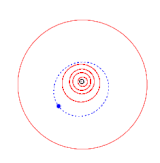Discovered by E. F. Helin MPC designation 9963 Sandage Observation arc 27.76 yr (10,139 days) Aphelion 3 m Discoverer Eleanor F. Helin | Discovery date 9 January 1992 Discovered 9 January 1992 Orbits Sun | |
 | ||
Alternative names 1992 AN · 1976 NH1989 CK6 Similar 4015 Wilson–Harrington, Sun, 6489 Golevka, 9969 Braille, 4769 Castalia | ||
9963 Sandage, provisional designation 1992 AN, is a stony Phocaea asteroid from the inner regions of the asteroid belt, approximately 6 kilometers in diameter. It was discovered by American astronomer Eleanor Helin at the U.S. Palomar Observatory in California on 9 January 1992.
The stony S-type asteroid is a member of the Phocaea family, a group of asteroids with similar orbital characteristics. It orbits the Sun at a distance of 1.7–3.0 AU once every 3 years and 7 months (1,308 days). Its orbit has an eccentricity of 0.28 and an inclination of 23° with respect to the ecliptic. The first used observation was taken at the German Karl Schwarzschild Observatory in 1989, extending the asteroid's observation arc by 3 years prior to its discovery.
Two rotational light-curve for this asteroid were obtained from photometric observations at the Palomar Transient Factory and at Texas Tech's Preston Gott Observatory in November 2011 and June 2016, respectively. The light-curves gave a rotation period of 4.65 hours with a high brightness variation of 0.56 and 0.43 in magnitude, respectively (U=2/3-).
According to the survey carried out by the NEOWISE mission of NASA's Wide-field Infrared Survey Explorer, the asteroid measures 6.4 kilometers in diameter and its surface has an albedo of 0.16, while the Collaborative Asteroid Lightcurve Link assumes an albedo of 0.23 – derived from the family's largest member and namesake, 25 Phocaea – and calculates a diameter of 5.5 kilometers, based on an absolute magnitude of 13.53.
The minor planet was named after American astronomer Allan Sandage (1926–2010), a worldwide known expert on stellar astronomy and observational cosmology, who worked at Palomar and Mount Wilson Observatory. Sandage determined the first reasonably accurate values for the Hubble constant and also discovered the first quasar. Naming citation was published on 2 September 2001 (M.P.C. 43381).
